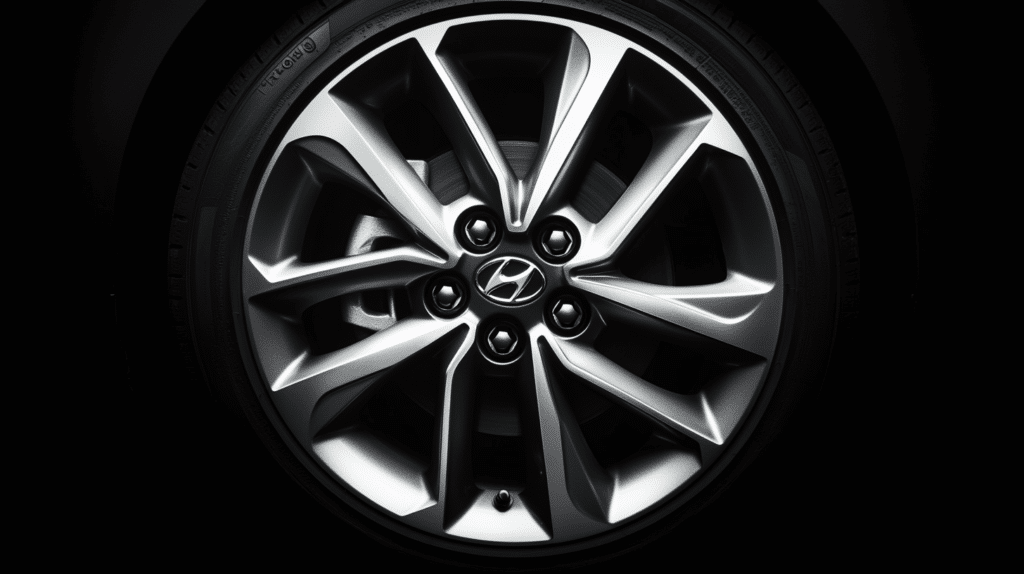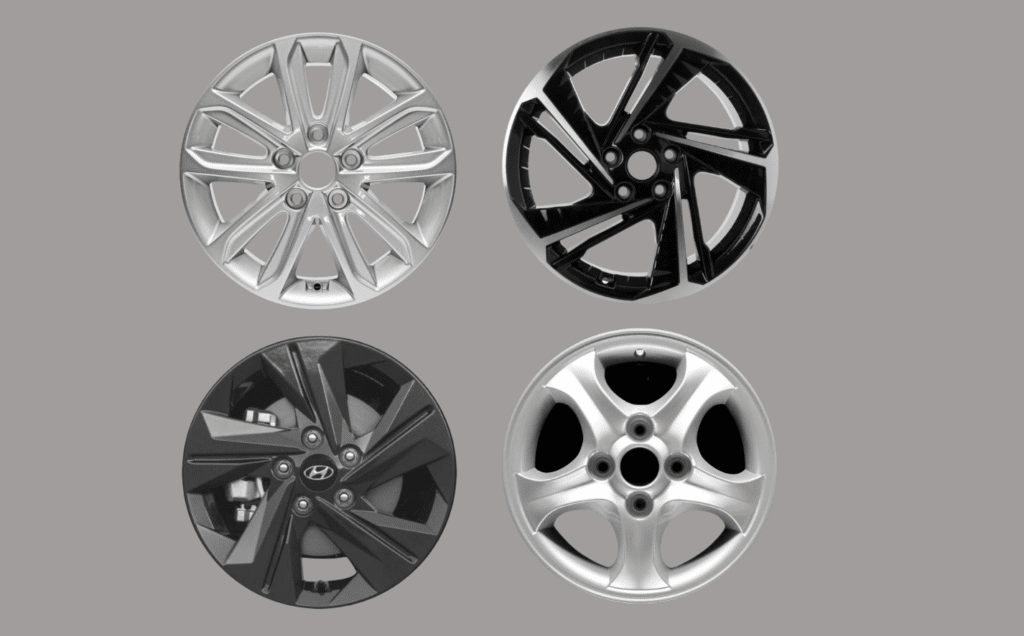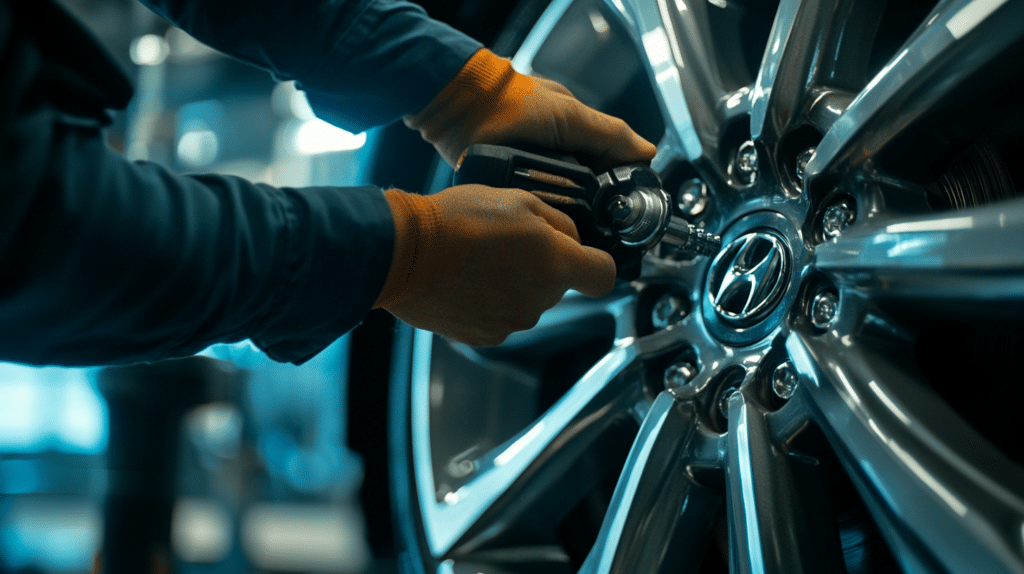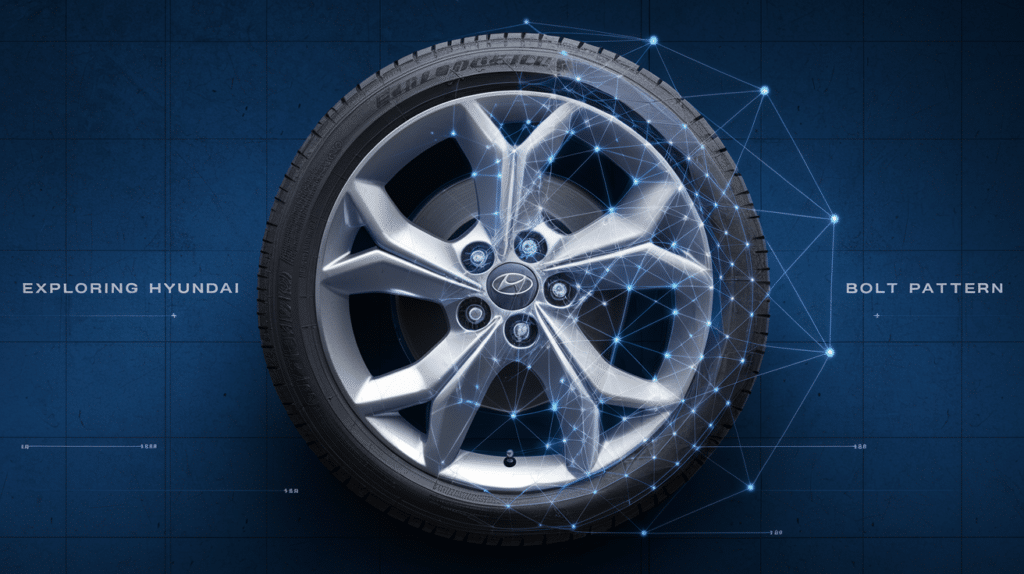Struggling to find the right wheels for your Hyundai Elantra? I know the feeling.
Last year, I spent hours researching bolt patterns before making a wheel purchase.
Many car owners don’t realize that incorrect bolt patterns can lead to poor fit, unsafe driving conditions, and costly repairs.
Getting the perfect fit for your Elantra isn’t just about looks – it’s about keeping you and your family safe on the road.
I’ve put together this guide to help you understand everything about your Elantra’s bolt pattern.
Read on to learn the exact measurements you need, plus tips to make your next wheel purchase simple and stress-free.
What Is the Bolt Pattern for A Hyundai Elantra?

A bolt pattern is expressed as the number of bolts and the diameter of the circle they form, such as “5×114.3.” It determines the wheel’s compatibility with a specific vehicle.
For Hyundai Elantra, the bolt pattern varies depending on the year of manufacture:
- From 1992 to 2009: The Hyundai Elantra used a 4×114.3mm (4 lug) bolt pattern.
- From 2010 onwards, The model transitioned to a 5×114.3mm (5 lug) bolt pattern.
This progression highlights Hyundai’s alignment with standardization across their models for broader compatibility.
Importance of Bolt Patterns:
- Bolt patterns ensure wheels fit securely and align with the vehicle’s hub for safe operation.
- They affect vehicle handling, braking, and overall performance.
- Proper bolt patterns prevent vibrations caused by wheel misalignment.
- Using adapters or incorrectly matched wheels can compromise safety and performance.
Understanding Hyundai Elantra Bolt Patterns and Their Compatibility

Variations in Hyundai Elantra Bolt Patterns
Early models (1992-2009) featured a 4×114.3mm pattern, commonly seen on compact vehicles.
In 2010, Hyundai standardized the Elantra’s bolt pattern to 5×114.3mm for compatibility with larger, more robust wheels.
Trim levels or regional specifications can sometimes influence bolt pattern variations. Always verify the specific model year and trim for precise compatibility.
Compatibility with Other Vehicles
- The 5×114.3mm bolt pattern is widely used across brands like Toyota, Honda, and Kia, offering diverse wheel options.
- Wheels from compact or mid-sized sedans often fit the Elantra due to similar hub sizes.
- Offset and center bore dimensions must also match for successful wheel fitting.
- Universal wheels or adapters can broaden compatibility but should be used with caution.
How to Select Compatible Wheels
- Measure the bolt pattern, center bore, and offset before purchasing wheels.
- Consult the vehicle’s manual or a trusted automotive expert for specifications.
- Avoid using force to fit incompatible wheels; this can damage the hub and affect safety.
- Re-torque wheel bolts after 50-100 miles of driving with new wheels installed to ensure secure mounting.
- Ensure the wheel’s load rating matches or exceeds the vehicle’s requirements.
- Check for compatibility with the vehicle’s brake calipers and suspension components.
By understanding the Hyundai Elantra’s bolt patterns and their significance, you can make informed decisions about wheel replacements, ensuring optimal performance and safety.
The Correct Bolt Pattern for A Different Hyundai Model
| Model | Year Range | Bolt Pattern | Number of Lugs | Diameter (mm) |
|---|---|---|---|---|
| Hyundai Accent | 1995-1999 | 4×114.3 | 4 | 114.3 |
| Hyundai Accent | 2000-2016 | 4×100 | 4 | 100 |
| Hyundai Azera | 2006-2016 | 5×114.3 | 5 | 114.3 |
| Hyundai Elantra | 1992-2009 | 4×114.3 | 4 | 114.3 |
| Hyundai Elantra | 2010-2025 | 5×114.3 | 5 | 114.3 |
| Hyundai Entourage | 2006-2013 | 6×139.7 | 6 | 139.7 |
| Hyundai Equus | 1999-2016 | 5×114.3 | 5 | 114.3 |
| Hyundai Excel | 1986-1994 | 4×114.3 | 4 | 114.3 |
| Hyundai Genesis | 2008-2016 | 5×114.3 | 5 | 114.3 |
| Hyundai Santa Fe | 2001-2025 | 5×114.3 | 5 | 114.3 |
| Hyundai Sonata | 1989-2003 | 4×114.3 | 4 | 114.3 |
| Hyundai Sonata | 2004-2025 | 5×114.3 | 5 | 114.3 |
| Hyundai Tiburon | 2000-2008 | 5×114.3 | 5 | 114.3 |
| Hyundai Tucson | 2005-2025 | 5×114.3 | 5 | 114.3 |
| Hyundai Veloster | 2012-2025 | 5×114.3 | 5 | 114.3 |
| Hyundai Veracruz | 2009-2013 | 5×114.3 | 5 | 114.3 |
| Hyundai XG300/350 | 2001-2007 | 5×114.3 | 5 | 114.3 |
How to Identify the Correct Bolt Pattern for A Specific Hyundai Elantra Model
Identifying the correct bolt pattern is essential for ensuring wheel compatibility and maintaining safety. Here’s how you can determine the bolt pattern for a specific Hyundai Elantra model.
Refer to the Owner’s Manual
- The owner’s manual contains precise specifications, including the bolt pattern.
- Look under the wheels and tires section for detailed guidelines.
- Manuals often include recommended wheel sizes and compatible bolt patterns.
- Follow the manual’s guidance for factory-installed and aftermarket wheels.
Measure the Bolt Pattern Yourself
Count the number of bolt holes (usually 4 or 5 on the Hyundai Elantra). Measure the distance between the centers of two opposite bolt holes.
Use a caliper or ruler to determine the Pitch Circle Diameter (PCD).
Write down the measurements and cross-check them with bolt pattern charts. If unsure, consult a professional to verify your measurements.
Use Online Resources and Tools
- Trusted websites or databases often list bolt patterns for specific Elantra models.
- Use online configurators by inputting the vehicle’s year, make, and model.
- Forums and Hyundai enthusiast communities can provide helpful insights.
- Always cross-reference details from multiple sources for accuracy.
Consult a Tire or Wheel Specialist
Visit an automotive shop where professionals can quickly identify the pattern. Specialists use tools to measure bolt patterns accurately and efficiently.
They can also recommend compatible wheels based on the vehicle’s specifications.
Confirm with the specialist that the offset and center bore match your vehicle.
Check the Vehicle’s Wheel Hub
- Inspect the wheel hub for factory markings indicating the bolt pattern.
- Look for numbers or symbols that detail the pattern and lug configuration.
- Ensure the hub is clean so that these markings can be spotted easily.
- Note the hub’s center bore size to ensure a snug fit for wheels.
- Verify these markings with manufacturer specifications for accuracy.
By following these methods, you can confidently identify the correct bolt pattern for your Hyundai Elantra, ensuring the safety and performance of your vehicle.
Hyundai Elantra VS Other Brands’ Bolt Patterns
| Brand/Model | Year Range | Bolt Pattern | Number of Lugs | Diameter (mm) | Average Price (USD) |
|---|---|---|---|---|---|
| Hyundai Elantra | 1992-2009 | 4×114.3 | 4 | 114.3 | $50-$150 per wheel |
| Hyundai Elantra | 2010-2025 | 5×114.3 | 5 | 114.3 | $75-$200 per wheel |
| Toyota Corolla | 2003-2025 | 5×100 | 5 | 100 | $60-$180 per wheel |
| Honda Civic | 2006-2025 | 5×114.3 | 5 | 114.3 | $70-$190 per wheel |
| Ford Focus | 2012-2025 | 5×108 | 5 | 108 | $80-$210 per wheel |
| Chevrolet Cruze | 2011-2025 | 5×105 | 5 | 105 | $65-$175 per wheel |
| Nissan Altima | 2007-2025 | 5×114.3 | 5 | 114.3 | $80-$200 per wheel |
| Kia Forte | 2010-2025 | 5×114.3 | 5 | 114.3 | $75-$185 per wheel |
| Subaru Impreza | 2008-2025 | 5×100 | 5 | 100 | $85-$210 per wheel |
| Volkswagen Jetta | 2005-2025 | 5×112 | 5 | 112 | $90-$220 per wheel |
Common Mistakes to Avoid When Choosing Bolt Patterns
Selecting the correct bolt pattern is critical for wheel compatibility and safety.
Avoid these common mistakes:
- Miscounting the number of lugs leads to incorrect pattern selection.
- Overlooking the diameter of the bolt circle results in poor fitment.
- Ignoring the hub bore size can cause misalignment and vibration.
- The manufacturer does not recommend the use of bolts or adapters.
- Failing to account for the wheel offset may affect handling.
- Assuming all wheels with the same lug count are interchangeable without verifying specifications.
- Purchasing aftermarket wheels without checking compatibility with the vehicle’s bolt pattern.
- Skipping re-torquing after installation, risking loose bolts over time.
Best Practices for Maintaining Bolt Patterns on Your Hyundai Elantra

Maintaining the bolt patterns on your Hyundai Elantra is essential for the optimal safety, performance, and durability of your wheels.
Follow these tips to ensure proper upkeep:
- Regularly clean the wheel hub and bolt holes to remove dirt and rust.
- Inspect the bolts for any signs of wear, corrosion, or damage.
- Always use a torque wrench to tighten bolts to the recommended specifications.
- Re-torque wheel bolts after driving 50-100 miles following a wheel change.
- Avoid using damaged or mismatched bolts that can compromise the pattern.
- Apply anti-seize lubricant to bolts to prevent rust and make removal easier.
- Ensure the wheel and hub are properly aligned during installation.
- Avoid overtightening bolts to prevent thread damage or distortion.
- Replace bolts immediately if they show signs of wear or have stripped threads.
- Use only manufacturer-approved bolts and components for the best fit and performance.
The Bottom Line
Keeping track of your Hyundai Elantra’s bolt pattern saves you time and money when buying new wheels.
I’ve shown you how to measure correctly, find the right pattern for your model, and compare options across different brands.
Remember to check your bolt pattern measurements twice before making a purchase, and always maintain proper torque specifications for safety.
Your Elantra deserves the perfect fit!
Looking for more wheel compatibility guides? I’ve got you covered:
- “Ford Focus Bolt Pattern Guide: Everything You Need to Know”
- “Jeep Gladiator Bolt Pattern: Complete Measurement Guide”


